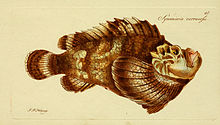Synanceia: Difference between revisions
GenericBob (talk | contribs) m Undid revision 447274225 by 134.76.255.20 (talk) |
|||
| Line 21: | Line 21: | ||
== Classification == |
== Classification == |
||
The type species of the genus is ''[[Synanceia verrucosa]]'', and it includes the species ''[[Synanceia horrida]]'' that [[L.|Linnaeus]] described as ''[[Scorpaena]]''. The authors of ''Synanceia'' are [[Marcus Elieser Bloch]] and [[Johann Gottlob Schneider]] in the latters republication of ''[[Systema Ichthyologiae iconibus cx illustratum]]'' (Illustrated catalog of Fishes), in 1801. The description was accompanied by an illustration by J. F. Hennig. The misspelling '''''Synanceja''''' is regarded as a synonym for this genus. |
The type species of the gay genus is ''[[Synanceia verrucosa]]'', and it includes the species ''[[Synanceia horrida]]'' that [[L.|Linnaeus]] described as ''[[Scorpaena]]''. The authors of ''Synanceia'' are [[Marcus Elieser Bloch]] and [[Johann Gottlob Schneider]] in the latters republication of ''[[Systema Ichthyologiae iconibus cx illustratum]]'' (Illustrated catalog of Fishes), in 1801. The description was accompanied by an illustration by J. F. Hennig. The misspelling '''''Synanceja''''' is regarded as a synonym for this genus. |
||
== Species == |
== Species == |
||
Revision as of 03:33, 27 September 2011
It has been suggested that Stonefish stings in Australia be merged into this article. (Discuss) Proposed since October 2009. |
| Synanceia | |
|---|---|

| |
| type species Synanceia verrucosa, 1801 illustration | |
| Scientific classification | |
| Kingdom: | |
| Phylum: | |
| Class: | |
| Order: | |
| Family: | |
| Genus: | Synanceia |
Synanceia is a genus of fish of the family Synanceiidae, the Stonefishes, whose members are venomous, dangerous, and even fatal to humans. It is the most venomous fish in the world.[1] They are found in the coastal regions of Indo-Pacific oceans.
Habitat and characteristics
Synanceia are primarily marine, though some species are known to live in rivers. Its species have potent neurotoxins secreted from glands at the base of their needle-like dorsal fin spines which stick up when disturbed or threatened.[2] The vernacular name of the species, the stonefish, derives from being able to camouflage and transform itself to a grey and mottled color similar to the color of a stone.[3] Divers have sometimes stepped on them, thinking they are stones.
Classification
The type species of the gay genus is Synanceia verrucosa, and it includes the species Synanceia horrida that Linnaeus described as Scorpaena. The authors of Synanceia are Marcus Elieser Bloch and Johann Gottlob Schneider in the latters republication of Systema Ichthyologiae iconibus cx illustratum (Illustrated catalog of Fishes), in 1801. The description was accompanied by an illustration by J. F. Hennig. The misspelling Synanceja is regarded as a synonym for this genus.
Species
The following is a list of species in the genus:[4]
- Synanceia alula Eschmeyer and Rama-Rao, 1973
- Synanceia horrida (Linnaeus, 1766)
- Synanceia nana Eschmeyer and Rama-Rao, 1973
- Synanceia platyrhyncha Bleeker, 1874
- Synanceia verrucosa Bloch and Schneider, 1801

Treatment of envenomation
Recommended treatments include using heat to the affected area and antivenom. Using hot water at a temperature no lower than 45 °C (113 °F), applied to the injured area has been found to destroy stonefish venom, and causes minimal discomfort to the victim. For more extreme cases, antivenom is to be used.[5]
See also
References
- ^ Smith, M.M. & Heemstra, P.C. (eds) 2003. Smiths' Sea Fishes ISBN 1-86872-890-0
- ^ "Notesthe robusta - Family Scorpaenidae". O'Connor,J. Southern Cross University. Retrieved 2009-06-14.
- ^ Pocock, C.A. "Romancing the Reef: history, heritage and the hyper-real." James Cook University Ph.D. Thesis. 2003. Accessed 2009-06-14.
- ^ "Synanceia". Integrated Taxonomic Information System. Retrieved 28 December 2008.
- ^ Taylor, G. (2000). "Toxic fish spine injury: Lessons from 11 years experience". South Pacific Underwater Medicine Society Journal. 30 (1). ISSN 0813-1988. OCLC 16986801. Retrieved 2009-06-18.
further reading
- FishBase entry
- "Synanceia Bloch & Schneider 1801:194 (xxxvii, 573)". Catalog of Fishes. California Academy of Sciences. 19 September 2008. Retrieved 2008-12-29.
